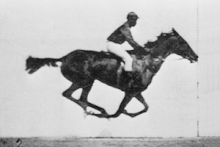Chronophotography
The chronophotography (also Fotochronografie ) refers to the photographic documentation of movements or processes, today mainly as a high-speed photography .
history
In the development of photography in the 1870s and 1880s, sensitive photographic materials and fast camera shutters made it possible to take so-called “instantaneous photographs”, recordings of moving objects. The pioneers of chronophotography ( Ottomar Anschütz , Albert Londe , Étienne-Jules Marey , Eadweard Muybridge ) developed various techniques to make movement sequences visible through a rapid sequence of photos ( series photography ). The terms serial photography , chronophotography or photochronography were originally used synonymously.
Muybridge succeeded 1878, the evidence that a horse in Gallop stands for a short time with all four hooves from the ground. These early series recordings provided important impulses for the development of "moving images" and were thus also the forerunners of the cinema .
High speed photography
Today, chronophotography mainly refers to a branch of photography that deals with the recording of fast movements, for example movements of animals and people, a bullet at the moment of impact, a balloon at the moment of bursting. The aim is to "freeze" movements in several phases in order to make them visible to the lazy human eye .
Depending on the application, it is crucial to find the right moment for the picture and to expose it very briefly, typically 1/1000 of a second to 1 / 30,000 of a second ( short-term photography ). With the help of a stroboscopic flash , several phases of movement can be represented in one shot according to this principle ( multiple exposure ).
With pulsed lasers as a stroboscope light source, exposure times of 25 ns (1 / 40,000,000 s) are possible.
Other pioneers of high-speed photography
- Wordsworth Donisthorpe (1847-1914)
- Ernst Kohlrausch (1850–1923)
- Harold E. Edgerton (1903-1990)
See also
Web links
- "Flying crane" series from around 1890 by Ottomar Anschütz ( Otto Lilienthal Museum )
- http://mnd-w1.fh-friedberg.de/wpfoto/pdf/Hoch Speed.pdf (PDF; 495 KiB)
- Waterdrop
- Collection of high-speed camera recordings in the fields of research, sports, art and industry
Individual evidence
- ↑ High Speed Imaging ( Memento from January 14, 2011 in the Internet Archive ) Stroboscopic lighting with copper vapor laser .


